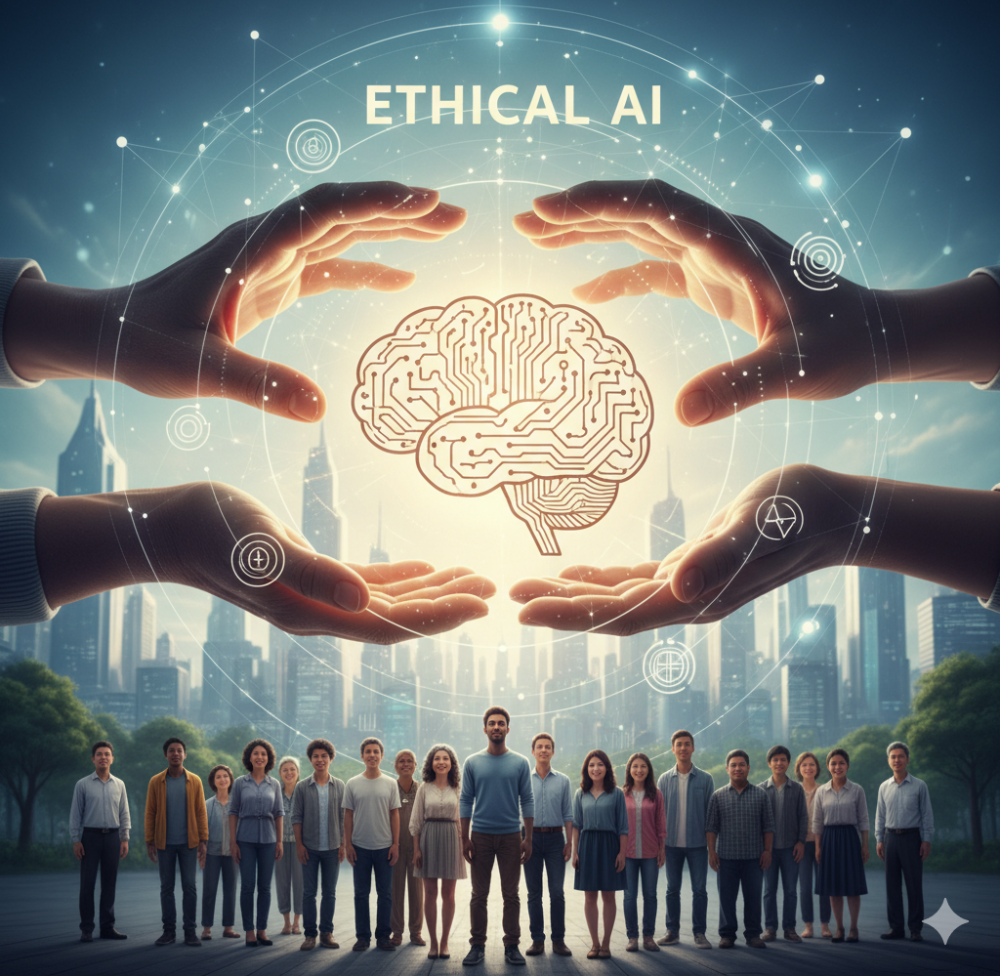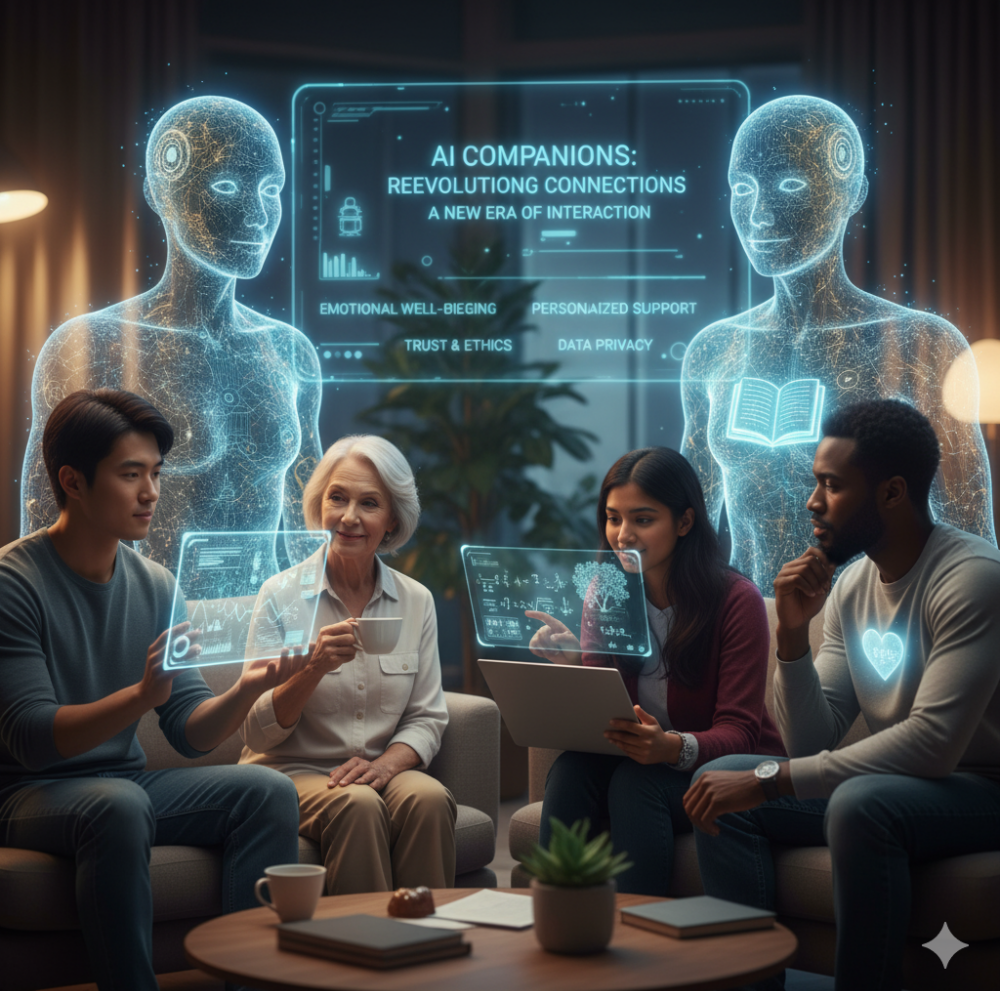
The Responsible Revolution: A Definitive Guide to Ethical AI Usage and Governance
Introduction: The Unfolding Imperative of Ethical AI
Artificial intelligence is rapidly reshaping the foundational dynamics of modern society, influencing everything from global supply chains and finance to personal healthcare decisions and civic engagement. AI is fundamentally changing how people spend, connect, and process information. The technological capability of AI systems is no longer the central challenge; rather, the critical question facing leaders today is how to guide this powerful force with clear ethical frameworks to ensure it serves humanity, fostering collective progress rather than causing unintended systemic harm.
The future success and widespread adoption of AI deployment hinge entirely upon establishing rigorous, human-centric ethical guardrails and operational governance systems. This guide transitions from the abstract philosophy of ethical AI to the concrete mechanisms required for implementation, offering a blueprint for organizations, policymakers, and technologists. It analyzes the core principles, explores leading governance frameworks, showcases real-world industry implementations, and forecasts the future regulatory landscape necessary for trustworthy AI.
Part I: Understanding Ethical AI: Foundations and Importance
1.1 The Moral Compass of AI: Defining Ethics, Principles, and Foundational Values
Ethical AI refers to a comprehensive approach that is both philosophical—focused on abstract principles like privacy and fairness—and practical—examining the broader societal implications of widespread AI usage, such as its impact on the environment or labor markets. At its core, AI ethics is a set of moral principles that enables stakeholders to discern between appropriate and harmful uses of the technology.
The cornerstone of ethical AI is the unwavering protection of human rights and dignity. The UNESCO Recommendation on the Ethics of Artificial Intelligence emphasizes that this commitment is translated through foundational principles, always demanding consistent human oversight of AI systems. These core values extend beyond the individual to encompass broader societal goals: ensuring human rights and dignity, promoting diverse and inclusive societies, supporting peaceful and just communities, and maintaining the flourishing of the environment and ecosystem.
These high-level values are operationalized through a common set of key principles now standardized across governmental and industry frameworks, including fairness, transparency, explainability, accountability, robustness, and privacy.
1.2 The Societal Imperative: Why Ethical AI is the Only Path Forward
When guided by established ethical standards, AI systems transcend their function as mere tools, becoming a powerful force for knowledge sharing, fairness, and overall collective progress. This responsible application is vital for bridging knowledge gaps and ensuring that new digital platforms shape social dynamics positively.
Globally, consensus is building around human-centered guidelines for ethical deployment. These guidelines necessitate focusing on seven critical areas: respecting human freedoms and rights; minimizing potential safety and security limitations; promoting equal distribution and limiting discrimination; mitigating environmental harm; ensuring robust data governance; protecting human autonomy and self-sufficiency; and building explainable and transparent systems. The World Economic Forum similarly underscores the need to empower humans, minimize bias, center deployment around privacy, and apply human oversight.
Furthermore, maintaining ethical standards plays a crucial role in self-policing the technological landscape. Accessible resources and even AI tools themselves can be deployed to detect and mitigate unethical behavior, such as the creation and dissemination of fake content, biased data sources, and other fraudulent digital assets, often performing these detection tasks more efficiently than humans.
1.3 The Cost of Neglect: Mapping the Risks and Repercussions of Unethical AI Applications
The failure to implement effective ethical guardrails carries significant risks that can perpetuate and amplify existing societal problems.
Inherited and Amplified Bias
AI systems often inherit and exacerbate biases present in their training data, leading directly to skewed and potentially harmful outcomes. This algorithmic bias manifests in real-world discrimination, such as applicant tracking systems unfairly disadvantaging certain genders, healthcare diagnostics providing lower accuracy results for historically underserved communities, or predictive policing tools disproportionately targeting marginalized groups. This disparate impact turns unintentional technical failure into systemic injustice, violating the foundational principle of fairness.
The Transparency and “Black Box” Problem
A significant ethical challenge is the lack of transparency and explainability in many modern AI algorithms, particularly deep learning models, which are often characterized as “black boxes”. Their complexity makes their decision-making processes difficult or impossible for human users or regulators to interpret and understand. This opacity directly undermines accountability, as stakeholders cannot effectively scrutinize or challenge decisions made by the system.
Privacy, Autonomy, and Economic Disruption
The operation of effective AI systems typically requires access to massive amounts of data, including highly sensitive personal information, which introduces severe risks regarding privacy violations. Strict data protection measures are essential to safeguard individual rights. Moreover, as AI systems assume greater degrees of autonomy and control in critical domains, concerns arise regarding the potential loss of ultimate human control and oversight. Compounding these concerns, the efficiency gained through automation via AI carries the risk of significant job displacement and, consequently, exacerbating economic inequality.
1.4 Public Sentiment and Industry Demographics: Navigating the Trust Deficit
Analysis of public sentiment reveals a complex and contradictory view of AI. Globally, there is a rising, albeit cautious, optimism regarding the benefits of AI products and services, with the proportion of people viewing AI as more beneficial than harmful rising from 52% in 2022 to 55% in 2024. A growing majority of the global population now expects AI-powered products to significantly impact their daily lives within the next three to five years.
However, this rising general optimism regarding AI’s utility coexists with a profound and deepening distrust in the custodians of the technology. Confidence that AI companies adequately protect personal data fell from 50% in 2023 to 47% in 2024. Crucially, fewer people now believe that AI systems are unbiased and free from discrimination. This phenomenon, often termed the trust paradox, means that the public accepts the potential value of AI but simultaneously distrusts the organizations and the ethical conduct underlying its development. This gap is highlighted by sustained skepticism in certain applications, such as self-driving cars, which 61% of Americans fear. This critical erosion of trust serves as a primary driver for the urgent regulatory and governance mandates emerging globally.
This public trust deficit is intrinsically linked to technical implementation challenges, specifically the difficulty organizations face in accessing the necessary demographic data to detect and mitigate bias. Many bias detection techniques rely on demographic traits of service users, but privacy laws and service provider constraints often make this data access challenging. This scenario creates a significant trade-off between two core ethical principles: Fairness, which requires representative demographic data for auditing, and Privacy, which demands data minimization and anonymization. Addressing this complexity requires novel solutions, such as the use of data intermediaries and proxies, to enable the monitoring necessary for fair outcomes.
Part II: Core Principles of Ethical AI: A People-First Approach
2.1 The Key Principles of Ethical AI: Fairness, Transparency, Accountability, and Equity
Moving from philosophical values to operational requirements, ethical AI frameworks establish core principles that guide the responsible development and deployment of technology.
- Fairness and Equity: These principles demand that AI systems must not perpetuate or amplify biases and must ensure equitable treatment and inclusive outcomes across all demographic groups. Inclusivity dictates that AI tools must be designed to cater to diverse users, including those with disabilities or varied backgrounds.
- Transparency and Explainability: AI actors must commit to responsible disclosure, providing meaningful, context-appropriate information to foster a general understanding of the systems’ capabilities and limitations. Where feasible, clear and understandable information must be provided on the factors and processes that informed an algorithm’s decision.
- Accountability: Clear ownership must be established throughout the AI lifecycle so that organizations and individuals can definitively take responsibility for AI outcomes. Accountability requires strong oversight mechanisms and ensuring that human judgment remains the final authority in critical decision-making.
- Reliability and Safety: Systems must be robust and secure, proactively addressing unwanted harms (safety risks) and vulnerabilities to attack (security risks).
2.2 Augmenting Humanity: Real-World Applications Placing Humans at the Center
A fundamental ethical mandate for AI is that its purpose is to augment human intelligence and capabilities, not to replace them. This human-centric approach positions AI as a companion that automates repetitive processes and surfaces insights rapidly, freeing human teams to focus on higher-value work that demands nuance, creativity, and human judgment.
A crucial example of this augmentation mandate is found in healthcare, where AI tools assist but do not dominate. The IBM Watson Health system, for instance, helps oncologists rapidly sift through immense volumes of medical literature and patient records to recommend tailored cancer treatments. The AI’s function is advisory; the final, critical decision rests with the doctor and the patient together. This approach enhances the healthcare provider’s ability to detect issues and improves accuracy by reducing the risk of human error, all while building patient trust by ensuring the human expert remains in charge.
In this model of assistive technology, humans remain “in the loop” to review patterns or predicted outcomes generated by the machine. This not only ensures the AI is functioning properly and fairly but also provides essential human insights that machines cannot comprehend, making the process faster, more efficient, and ethically sound. This focus on augmentation is a powerful pre-emptive measure against the long-term risk of excessive dependence on AI systems, ensuring that organizations maintain vital human control and judgment.
2.3 The Diversity Dividend: Analyzing the Role of Diversity and Inclusion in Ethical AI Development
Diversity is not merely a social obligation but a critical quality control mechanism essential for technical performance and ethical compliance. Diversity within AI development teams—including data scientists, researchers, and developers—is necessary for three primary reasons: avoiding bias, improving system capabilities, and ensuring broad user representation.
Historical failures demonstrate that when systems are designed by homogenous teams, they risk optimization for specific demographics, leading to highly visible and damaging failures, such as computer vision systems failing to recognize Black women or people of color. These incidents demonstrate that an ethical failure is simultaneously a systemic failure.
To address this, organizations must embed principles of diversity and inclusion. This ensures that technologies are inclusive, equitable, and accessible across all demographics, preventing specific populations from being underserved or actively harmed. Furthermore, development must be guided by the data justice framework, which asserts the right of individuals and communities—especially those most at risk of algorithmic harm—to choose how and when their data is used. This calls for participatory design processes where input is gathered from diverse communities to refine solutions.
2.4 Understanding the Balance between Human Values and Technological Advancements
The ethical constraint placed on technological ambition is captured by the principles of proportionality and “do no harm”. The use of any AI system must be strictly proportional, meaning it cannot extend beyond what is legitimately necessary to achieve its intended aim. Risk assessments must be a mandatory step used to prevent predictable harms that may result from AI deployment.
As AI technology matures and moves toward Artificial General Intelligence (AGI), the ethical challenges become more profound. The focus shifts to the critical challenge of value alignment—ensuring that highly sophisticated AI goals remain fundamentally aligned with human values. As AGI systems gain increased capability and autonomy, the paramount ethical challenge is developing robust and reliable control methods to prevent unintended, potentially catastrophic consequences. This structural safeguard is necessary to ensure human values remain paramount, regardless of the technology’s complexity.
Part III: Setting Up Governance Frameworks: Ensuring Transparency and Accountability
3.1 Structuring Oversight: Defining What Constitutes Governance in Ethical AI
AI governance is the structured approach organizations and governments take to oversee the entire AI lifecycle—from initial design and development through to deployment and monitoring. It defines the standards, guardrails, policies, and accountability mechanisms necessary to balance the pursuit of innovation with the imperative for ethical responsibility and regulatory compliance.
Effective governance frameworks must provide clear answers to critical liability questions: How can fairness and transparency be demonstrably ensured? Who assumes responsibility when an AI system produces a harmful decision? And what real-time mechanisms are in place to detect and mitigate evolving risks?. Achieving this requires high-level organizational commitment and cross-functional collaboration, ensuring that legal, ethics, data science, and risk teams work together, establishing governance as a standard business practice rather than an ethical afterthought.
3.2 Regulatory Landscapes: Exploring Legal and Policy Frameworks Supporting Ethical AI Practices
The global landscape for AI governance is characterized by both mandatory compliance and voluntary risk management guidance, forcing multinational entities to navigate both complexity and fragmentation.
The EU AI Act
The EU AI Act represents the first comprehensive regulation on AI by a major regulator. It utilizes a tiered, risk-based approach to compliance:
- Unacceptable Risk: AI systems deemed a clear threat to fundamental rights are banned (e.g., government-run social scoring systems and manipulative techniques).
- High Risk: Systems used in critical sectors (e.g., medical devices, CV-scanning tools) are subject to stringent legal requirements. Providers of high-risk AI must adhere to obligations covering rigorous record-keeping, achieving appropriate levels of accuracy, maintaining system robustness and cybersecurity, implementing comprehensive quality management systems, and designing the systems to enable human oversight by deployers.
- Limited Risk: Systems like chatbots or deepfakes require lighter transparency obligations, primarily ensuring that the end-user is aware they are interacting with an AI.
The NIST AI Risk Management Framework (AI RMF)
In contrast to the EU Act’s mandatory structure, the National Institute of Standards and Technology (NIST) AI RMF provides voluntary, adaptable guidance for managing AI-related risks. This framework is designed to be systematic and flexible, tailoring its principles to organizations of all sizes and across various risk profiles.
The NIST AI RMF is built upon four interconnected functions, implemented iteratively throughout the AI system’s lifecycle :
- Govern: Focuses on organizational culture by establishing leadership commitment, defining clear governance structures, and cultivating an overall risk-aware environment. This function inherently establishes the basis for organizational accountability.
- Map: Contextualizes the AI system within its operating environment, identifying potential impacts across technical, ethical, and social dimensions.
- Measure: Assesses the likelihood and potential consequences of identified risks using both qualitative and quantitative approaches.
- Manage: Guides organizations in prioritizing, addressing, and mitigating risks through procedural safeguards and technical controls.
The co-existence of these frameworks shows regulatory convergence on core principles (fairness, transparency, accountability) but fragmentation in method (mandatory compliance versus voluntary guidance). This structure compels multinational organizations to harmonize their internal governance structures using the highest common denominator—often the mandatory EU standards—while maintaining the flexibility provided by frameworks like NIST.
3.3 Measuring Trust: Establishing Ethical AI Assessment Metrics
Ethical success cannot be assumed; it must be measurable. This requires establishing human-centric Key Performance Indicators (KPIs) that shift focus away from purely technical accuracy toward metrics that assess ethical alignment, trust, and social impact. True success is determined by whether ethical principles are demonstrably embedded into the organization’s strategy, workflows, and decision-making processes, rather than existing only as written policy.
The following table outlines key metrics used in governance frameworks:
Ethical AI Governance Assessment Metrics (KPIs)
PrincipleAssessment Metric (KPI)PurposeFairness & EquityDisparate Impact Ratio / Equal Opportunity Ratio
Objectively evaluate systemic discrimination across demographic subgroups.
TransparencyExplainability Coverage Rate
Quantify the percentage of critical AI decisions accompanied by human-readable justifications.
Accountability & RiskIncident Detection Rate and Response Time
Monitor the frequency of bias, failure, or drift incidents and the speed of mitigation.
CompliancePercentage of projects adhering to ethical guidelines
Track internal and external regulatory adherence across the AI project portfolio.
User TrustStakeholder satisfaction and feedback scores
Assess external perception of the AI system’s accountability and transparency.
Other vital metrics include data quality assessment (accuracy, relevance), security incident monitoring, and system uptime/reliability. By adopting these measures, organizations ensure that AI governance translates directly into quantifiable performance benchmarks.
3.4 Checks and Balances: The Critical Role of Independent Audits and Oversight
The opacity of complex algorithms (the “black box” problem) combined with rising skepticism of corporate self-regulation necessitates independent oversight. Internal ethical voices can be vulnerable to corporate pressures, as demonstrated by instances where leading ethics researchers departed companies amid controversies over bias. This highlights the need for structural independence.
The implementation of robust accountability mechanisms should include:
- Independent AI Auditors: Third-party watchdogs who can examine AI systems for safety and fairness without internal conflicts of interest. These auditors report findings publicly, establishing accountability through transparency rather than reliance on self-enforcement.
- Regulatory Mandates: Legal requirements that mandate the inclusion of qualified, independent AI expertise on corporate boards, akin to the financial expertise required by the Sarbanes-Oxley Act.
- Binding External Ethics Boards: Granting external ethics boards contractual authority to block AI deployments that violate predefined standards, transforming them from advisory roles into true accountability mechanisms.
AI audits are complex and require a formalized methodology. This process begins by establishing clear governance structures and engaging audit teams early in the development lifecycle. Organizations must inventory all AI systems (including generative models), conduct formal risk assessments to anticipate harms like data misuse or bias, select appropriate frameworks (like NIST), and continuously monitor the systems post-deployment. The use of AI itself can support this function, processing vast data sets faster and with fewer errors to strengthen overall audit quality.
The urgent need for this structural oversight is particularly evident in high-velocity sectors like finance. Although AI integration in authorized financial firms accelerated rapidly, including a near-tripling of Generative AI adoption by 2025, 21% of firms surveyed still lack clear accountability or oversight mechanisms, creating significant systemic risk in a highly regulated domain.
Part IV: Ethical AI in Practice: Successful Implementations Across Industries
4.1 Showcase Case Studies of Ethical AI Implementations
Ethical AI principles are being operationalized across high-stakes industries, demonstrating the capacity to address bias and enhance human well-being.
Healthcare: Inclusive Diagnostics and Data Equity
AI in healthcare promises improved diagnostics and personalized medicine, yet models trained on homogeneous patient data risk significant discrimination and errors when applied to underrepresented and medically vulnerable communities.
The ethical solution demands a multifaceted approach. Implementation requires rigorous, inclusive data collection efforts that actively recruit diverse demographic groups. This must be paired with continuous training for healthcare providers, standardized protocols for data collection and labeling, and, critically, regular equity audits of the AI systems. The overall goal is to advance responsible and equitable AI use in public health by ensuring the models are designed inclusively for all populations.
Finance: Fairness and Inclusion in Credit Scoring
The finance sector has struggled with the risk of disparate impact, where AI lending algorithms have systematically disadvantaged specific groups, such as assigning lower credit scores or limits to women or minority borrowers despite similar financial behaviors.
Ethical financial institutions are now employing fairness-aware machine learning techniques, including adversarial debiasing and re-weighting training datasets, backed by ongoing algorithmic audits. This process includes resolving the inherent conflict between the need for demographic data (Fairness) and data minimization (Privacy) through techniques like anonymization. Furthermore, ethical deployment actively promotes financial inclusion by leveraging non-traditional metrics, such as utility and rent payments, to extend credit access to historically underbanked populations, thus fostering financial equity through algorithmic design.
Education: Transparent Personalized Learning Systems
In education, AI systems often personalize learning by gathering sensitive student data, creating high demands for data security and privacy protection. There is also a risk of over-reliance on AI, which could limit student engagement with faculty and peers.
Ethical AI in education mandates strong data protection policies and complete transparency regarding what data is collected and how it is used. Students and guardians should have input on data storage decisions. Institutionally, AI must complement, not replace, human-led instruction, acting only as an assistant to human instructors. Regular pedagogical and technical evaluations are essential to monitor system quality, prevent algorithmic assumptions based on demographics, and ensure continued alignment with educational goals.
4.2 Quantifying Ethical Success: Measuring the Effectiveness of Initiatives
Measuring the effectiveness of ethical AI initiatives must move beyond traditional technical performance metrics like system uptime or accuracy. Success is found in assessing whether the governance program maintains oversight, manages risk, addresses ethical implications, and secures organizational adoption.
Key measures include tracking compliance (the percentage of projects that adhere to established ethical guidelines), monitoring the response time required to mitigate bias or failure incidents, and utilizing stakeholder feedback surveys to gauge user satisfaction with system transparency and accountability. Ultimately, effectiveness is confirmed when organizations demonstrate that ethical principles are successfully embedded into daily workflows and strategic decision-making processes.
4.3 The Business Case: Long-Term Benefits for Corporate Reputation and Consumer Trust
Ethical AI is not merely a compliance burden but a strategic imperative that yields tangible long-term competitive benefits. Ethical practices enhance the customer experience by building trust and fostering loyalty.
Transparency about how AI systems use customer data, coupled with fairness that ensures systems are free from bias, significantly increases customer satisfaction and trust. Conversely, unethical practices result in severe negative consequences, including a loss of consumer trust, legal repercussions, and long-lasting damage to corporate reputation. Companies that successfully integrate responsible AI frameworks benefit from strengthened customer relationships and enhanced brand loyalty, which directly supports sustainable long-term business growth and provides a competitive advantage.
Part V: The Path Forward: Future Challenges and Opportunities in Ethical AI
5.1 The Next Wave: Emerging Trends and Technologies Influencing Ethical AI
The regulatory and ethical landscape must remain dynamic to address rapidly evolving technologies.
The proliferation of Generative AI (GenAI), which has seen accelerated adoption across sectors like finance , requires swift adaptation of governance frameworks to mitigate new risks, such as the mass production of deepfakes and the spread of coordinated misinformation. The EU AI Act attempts to address this with light transparency obligations for deepfakes, but comprehensive standards remain necessary.
The anticipated development of Artificial General Intelligence (AGI) introduces profound ethical concerns related to preventing unintended or catastrophic consequences. As AGI systems become highly autonomous and capable, the ethical focus shifts to ensuring system control and preventing unexpected, harmful solutions. This challenge requires concerted efforts from governments, researchers, and businesses to ensure alignment with human well-being.
International organizations recognize the need for this dynamic approach. The UNESCO Recommendation deliberately uses a broad interpretation of AI to ensure the standards remain applicable even as technology evolves, thereby making future-proof policies feasible.
5.2 Navigating the Barriers: Challenges to Continued Ethical AI Development and Acceptance
Despite widespread recognition of the need for ethical AI, several formidable challenges persist.
The complexity of advanced algorithms creates the problem of opacity and inscrutable evidence. When AI decisions are based on data or processes that are inconclusive or impossible to fully trace, the ability to rectify errors or assign responsibility is severely limited. This opacity directly undermines the principle of accountability.
Another significant risk is the danger of excessive dependence on intelligent systems. If users rely too heavily on AI, the consequences of a system breakdown or an unexplainable, hasty decision (such as in an autonomous vehicle) could be severe, especially since experts often do not fully understand how complex algorithms might fail.
Furthermore, public acceptance is challenged by persistent skepticism and declining institutional trust. Worries about the potential for AI abuses to affect critical societal functions, such as elections and political processes, can diminish feelings of civic engagement and further erode institutional trust. Ethical governance must therefore expand its scope beyond corporate liability to safeguard civic health.
5.3 Strategic Solutions: Overcoming Barriers to Ethical AI Adoption
Overcoming these barriers requires a commitment to policy action, standardization, and technological investment.
The UNESCO framework provides a model by translating core ethical values into comprehensive Policy Action Areas spanning gender, health, data governance, and education. This multidisciplinary approach ensures that ethical integration is holistic.
Widespread and consistent adoption of established standardization and frameworks, particularly the NIST RMF and regulatory mandates like the EU AI Act for high-risk domains, offers organizations a structured and industry-aligned playbook for achieving compliance and mitigating risk.
Technological investment must focus on Explainable AI (XAI) tools. Continued research and development in this area are necessary to address the challenge of opacity, ensuring that even complex decisions can be accompanied by human-readable justifications, thereby supporting both regulatory compliance and user trust.
5.4 Forecasting the Future: Ethical Innovation and Global Regulation
The increasing societal consequence and complexity of AI systems ensure that the regulatory environment will continue to intensify. The future will likely see a move toward harmonized regulatory expectations across jurisdictions, supported by increased use of AI regulatory sandboxes and industry-developed codes of practice to smooth the path between technological innovation and mandatory compliance.
The next decade will see a shift where ethical design becomes a key driver of innovation. Market leadership will be claimed by organizations that successfully integrate measurable fairness metrics, diversity principles, and consistent human oversight into their development pipeline, viewing ethical compliance not as a burden but as a primary strategic advantage.
Crucially, as the technology moves toward AGI, the accountability challenge will sharpen. If complexity continues to rise without commensurate gains in explainability, regulators may be forced to impose technical limits on system opacity in high-stakes domains or mandate guaranteed human override mechanisms—a kind of ethical circuit breaker—to ensure that human control can always override a catastrophic, unexplainable decision. This requires a profound acceptance of shared responsibility among researchers, governments, and businesses for managing the technology’s ultimate impact.
Conclusion: The Trust Imperative
The deployment of ethical AI systems is the defining responsibility of the current technological revolution. Ethical AI is a continuous process that demands perpetual vigilance, robust governance, diversity in development, and clear, measurable standards. The evidence demonstrates that organizations failing to implement structural oversight—especially independent audits and binding governance mechanisms—risk eroding public confidence, incurring severe financial and reputational damages, and perpetuating systemic harm.
The ultimate test of AI’s transformative power is not defined by its capabilities, but by how ethically and responsibly we choose to apply those capabilities. Organizations must move beyond mere philosophical discussions and strategically embed governance into their core operations, transforming ethical compliance into an indispensable strategic asset that ensures human rights and values remain paramount in the age of intelligent systems.
References
Brookings Center for Technology Innovation. (2024). Health and AI: Advancing responsible and ethical AI for all communities. Retrieved from https://www.brookings.edu/articles/health-and-ai-advancing-responsible-and-ethical-ai-for-all-communities/
Centers for Disease Control and Prevention (CDC). (2024). Multifaceted approach for ethical and equitable implementation of artificial intelligence (AI) in public health and medicine. Preventing Chronic Disease, 21. Retrieved from https://www.cdc.gov/pcd/issues/2024/24_0245.htm
Crescendo AI. (n.d.). Human-centric AI. Retrieved from https://www.crescendo.ai/blog/human-centric-ai
Dubai Financial Services Authority (DFSA). (2025, November 12). DFSA AI Survey 2025 report reveals: AI integration within DFSA Authorised Firms has accelerated rapidly. Mondovisione. Retrieved from https://mondovisione.com/media-and-resources/news/new-dubai-financial-services-authority-ai-survey-generative-ai-adoption-has-nea-20251112/
European Parliament. (n.d.). The AI Act. Retrieved from https://artificialintelligenceact.eu/
Harvard University, Division of Continuing Education. (n.d.). Building a responsible AI framework: 5 key principles for organizations. Retrieved from https://professional.dce.harvard.edu/blog/building-a-responsible-ai-framework-5-key-principles-for-organizations/
IBM. (n.d.). 10 AI dangers and risks and how to manage them. Retrieved from https://www.ibm.com/think/insights/10-ai-dangers-and-risks-and-how-to-manage-them
IBM. (n.d.). How does an AI governance expert measure success? Retrieved from https://www.ibm.com/think/insights/how-does-an-ai-governance-expert-measure-success
IBM. (n.d.). What is AI ethics? Retrieved from https://www.ibm.com/think/topics/ai-ethics
KPMG. (2024). The potential of AI in an audit context. Retrieved from https://assets.kpmg.com/content/dam/kpmgsites/ch/pdf/audit-with-ai-en.pdf.coredownload.inline.pdf
Microsoft. (n.d.). Responsible AI Standard. Retrieved from https://learn.microsoft.com/en-us/azure/machine-learning/concept-responsible-ai?view=azureml-api-2
National Institute of Standards and Technology (NIST). (n.d.). NIST AI Risk Management Framework. Palo Alto Networks Cyberpedia. Retrieved from https://www.paloaltonetworks.com/cyberpedia/nist-ai-risk-management-framework
OECD. (n.d.). OECD AI Principles. Retrieved from https://www.oecd.org/en/topics/sub-issues/ai-principles.html
Palo Alto Networks. (n.d.). NIST AI Risk Management Framework. Retrieved from https://www.paloaltonetworks.com/cyberpedia/nist-ai-risk-management-framework
Salesforce. (n.d.). Empower your business and workforce with human-centered AI. Retrieved from https://www.salesforce.com/agentforce/human-centered-ai/
Stanford University, Human-Centered Artificial Intelligence (HAI). (2024). AI Index 2024 Report: Public Opinion. Retrieved from https://hai.stanford.edu/ai-index/2025-ai-index-report/public-opinion
UNESCO. (2021). Recommendation on the Ethics of Artificial Intelligence. Retrieved from https://www.unesco.org/en/artificial-intelligence/recommendation-ethics
USC Annenberg Center for Public Relations. (n.d.). The ethical dilemmas of AI. Retrieved from https://annenberg.usc.edu/research/center-public-relations/usc-annenberg-relevance-report/ethical-dilemmas-ai
VerifyWise AI. (n.d.). Key performance indicators (KPIs) for AI governance. Retrieved from https://verifywise.ai/lexicon/key-performance-indicators-kpis-for-ai-governance
World Economic Forum. (n.d.). What are the 7 principles of ethical AI? Coursera. Retrieved from https://www.coursera.org/articles/ai-ethics
Zendata. (n.d.). AI metrics 101: Measuring the effectiveness of your AI governance program. Retrieved from https://www.zendata.dev/post/ai-metrics-101-measuring-the-effectiveness-of-your-ai-governance-program
 youtube.comAI and Ethics | Life Conversations Public ForumOpens in a new window
youtube.comAI and Ethics | Life Conversations Public ForumOpens in a new window professional.dce.harvard.eduBuilding a Responsible AI Framework: 5 Key Principles for Organizations – Professional & Executive DevelopmentOpens in a new window
professional.dce.harvard.eduBuilding a Responsible AI Framework: 5 Key Principles for Organizations – Professional & Executive DevelopmentOpens in a new window ibm.comWhat is AI Ethics? | IBMOpens in a new window
ibm.comWhat is AI Ethics? | IBMOpens in a new window unesco.orgOpens in a new window
unesco.orgOpens in a new window unesco.orgEthics of Artificial Intelligence | UNESCOOpens in a new window
unesco.orgEthics of Artificial Intelligence | UNESCOOpens in a new window learn.microsoft.comWhat is Responsible AI – Azure Machine Learning | Microsoft LearnOpens in a new window
learn.microsoft.comWhat is Responsible AI – Azure Machine Learning | Microsoft LearnOpens in a new window coursera.orgAI Ethics: What It Is, Why It Matters, and More – CourseraOpens in a new window
coursera.orgAI Ethics: What It Is, Why It Matters, and More – CourseraOpens in a new window ibm.com10 AI dangers and risks and how to manage them | IBMOpens in a new window
ibm.com10 AI dangers and risks and how to manage them | IBMOpens in a new window annenberg.usc.eduThe ethical dilemmas of AI | USC Annenberg School for Communication and JournalismOpens in a new window
annenberg.usc.eduThe ethical dilemmas of AI | USC Annenberg School for Communication and JournalismOpens in a new window mdpi.comPerception and Ethical Challenges for the Future of AI as Encountered by Surveyed New Engineers – MDPIOpens in a new window
mdpi.comPerception and Ethical Challenges for the Future of AI as Encountered by Surveyed New Engineers – MDPIOpens in a new window hai.stanford.eduPublic Opinion | The 2025 AI Index Report – Stanford HAIOpens in a new window
hai.stanford.eduPublic Opinion | The 2025 AI Index Report – Stanford HAIOpens in a new window gov.ukEnabling responsible access to demographic data to make AI systems fairer – GOV.UKOpens in a new window
gov.ukEnabling responsible access to demographic data to make AI systems fairer – GOV.UKOpens in a new window raisef.aiCase Study 2: Fairness in AI-Driven Credit Scoring – RAISEFOpens in a new window
raisef.aiCase Study 2: Fairness in AI-Driven Credit Scoring – RAISEFOpens in a new window medium.comAI Governance Framework. Artificial intelligence (AI) is no… | by SuperBusinessManager.com | Sep, 2025Opens in a new window
medium.comAI Governance Framework. Artificial intelligence (AI) is no… | by SuperBusinessManager.com | Sep, 2025Opens in a new window shrm.orgWhy Diversity in AI Makes Better AI for All: The Case for Inclusivity and Innovation – SHRMOpens in a new window
shrm.orgWhy Diversity in AI Makes Better AI for All: The Case for Inclusivity and Innovation – SHRMOpens in a new window inspera.comExamples of Ethical AI for Educators in Higher Education – InsperaOpens in a new window
inspera.comExamples of Ethical AI for Educators in Higher Education – InsperaOpens in a new window oecd.orgAI principles – OECDOpens in a new window
oecd.orgAI principles – OECDOpens in a new window hai.stanford.eduA Human-Centered Approach to the AI Revolution | Stanford HAIOpens in a new window
hai.stanford.eduA Human-Centered Approach to the AI Revolution | Stanford HAIOpens in a new window salesforce.comThe Future of Work Is Human-Centered AI – SalesforceOpens in a new window
salesforce.comThe Future of Work Is Human-Centered AI – SalesforceOpens in a new window crescendo.aiHuman-centric AI in 2025: Real-life Scenarios with Examples – Crescendo.aiOpens in a new window
crescendo.aiHuman-centric AI in 2025: Real-life Scenarios with Examples – Crescendo.aiOpens in a new window mckinsey.comThe case for human-centered AI | McKinseyOpens in a new window
mckinsey.comThe case for human-centered AI | McKinseyOpens in a new window partnershiponai.orgParticipatory and Inclusive Demographic Data Guidelines – Partnership on AIOpens in a new window
partnershiponai.orgParticipatory and Inclusive Demographic Data Guidelines – Partnership on AIOpens in a new window medium.comThe Ethics of Artificial General Intelligence (AGI): Navigating the Path to Human and Machine Coexistence. | by Gaurav Sharma | MediumOpens in a new window
medium.comThe Ethics of Artificial General Intelligence (AGI): Navigating the Path to Human and Machine Coexistence. | by Gaurav Sharma | MediumOpens in a new window ibm.comOpens in a new window
ibm.comOpens in a new window markets.financialcontent.comThe AI Imperative: Why Robust Governance and Resilient Data Strategies are Non-Negotiable for Accelerated AI AdoptionOpens in a new window
markets.financialcontent.comThe AI Imperative: Why Robust Governance and Resilient Data Strategies are Non-Negotiable for Accelerated AI AdoptionOpens in a new window artificialintelligenceact.euEU Artificial Intelligence Act | Up-to-date developments and analyses of the EU AI ActOpens in a new window
artificialintelligenceact.euEU Artificial Intelligence Act | Up-to-date developments and analyses of the EU AI ActOpens in a new window artificialintelligenceact.euHigh-level summary of the AI Act | EU Artificial Intelligence ActOpens in a new window
artificialintelligenceact.euHigh-level summary of the AI Act | EU Artificial Intelligence ActOpens in a new window paloaltonetworks.comNIST AI Risk Management Framework (AI RMF) – Palo Alto NetworksOpens in a new window
paloaltonetworks.comNIST AI Risk Management Framework (AI RMF) – Palo Alto NetworksOpens in a new window wiz.ioNIST AI Risk Management Framework: A tl;dr – WizOpens in a new window
wiz.ioNIST AI Risk Management Framework: A tl;dr – WizOpens in a new window magai.coUltimate Guide to Human-Centric AI KPIs – MagaiOpens in a new window
magai.coUltimate Guide to Human-Centric AI KPIs – MagaiOpens in a new window zendata.devAI Metrics 101: Measuring the Effectiveness of Your AI Governance Program – ZendataOpens in a new window
zendata.devAI Metrics 101: Measuring the Effectiveness of Your AI Governance Program – ZendataOpens in a new window ibm.comWhat Are the Key Metrics for Measuring AI Governance? – IBMOpens in a new window
ibm.comWhat Are the Key Metrics for Measuring AI Governance? – IBMOpens in a new window verifywise.aiKey performance indicators (KPIs) for AI governance – VerifyWise AI LexiconOpens in a new window
verifywise.aiKey performance indicators (KPIs) for AI governance – VerifyWise AI LexiconOpens in a new window jdsupra.comGoverning the Ungovernable: Corporate Boards Face AI Accountability ReckoningOpens in a new window
jdsupra.comGoverning the Ungovernable: Corporate Boards Face AI Accountability ReckoningOpens in a new window ibm.comWhat Is an AI Audit? | IBMOpens in a new window
ibm.comWhat Is an AI Audit? | IBMOpens in a new window assets.kpmg.comAI based Audit – KPMG InternationalOpens in a new window
assets.kpmg.comAI based Audit – KPMG InternationalOpens in a new window mondovisione.comNew Dubai Financial Services Authority AI Survey: Generative AI Adoption Has Nearly Tripled Within The DIFC In Last 12 Months As Governance Continues To DevelopOpens in a new window
mondovisione.comNew Dubai Financial Services Authority AI Survey: Generative AI Adoption Has Nearly Tripled Within The DIFC In Last 12 Months As Governance Continues To DevelopOpens in a new window brookings.eduHealth and AI: Advancing responsible and ethical AI for all communities | BrookingsOpens in a new window
brookings.eduHealth and AI: Advancing responsible and ethical AI for all communities | BrookingsOpens in a new window cdc.govHealth Equity and Ethical Considerations in Using Artificial Intelligence in Public Health and Medicine – CDCOpens in a new window
cdc.govHealth Equity and Ethical Considerations in Using Artificial Intelligence in Public Health and Medicine – CDCOpens in a new window researchgate.net(PDF) AI-Powered Credit Scoring Models: Ethical Considerations, Bias Reduction, and Financial inclusion Strategies – ResearchGateOpens in a new window
researchgate.net(PDF) AI-Powered Credit Scoring Models: Ethical Considerations, Bias Reduction, and Financial inclusion Strategies – ResearchGateOpens in a new window learningsciences.smu.eduHow to use AI in the classroom ethically and responsibly – Learning Sciences – SMUOpens in a new window
learningsciences.smu.eduHow to use AI in the classroom ethically and responsibly – Learning Sciences – SMUOpens in a new window researchgate.netImpact of Ethical AI on Customer Experience and Brand Loyalty – ResearchGateOpens in a new window
researchgate.netImpact of Ethical AI on Customer Experience and Brand Loyalty – ResearchGateOpens in a new window aijourn.comOpens in a new window
aijourn.comOpens in a new window coe.intCommon ethical challenges in AI – Human Rights and Biomedicine – The Council of EuropeOpens in a new window
coe.intCommon ethical challenges in AI – Human Rights and Biomedicine – The Council of EuropeOpens in a new window elon.eduNew survey finds most Americans expect AI abuses will affect 2024 election | Today at ElonOpens in a new window
elon.eduNew survey finds most Americans expect AI abuses will affect 2024 election | Today at ElonOpens in a new window
















